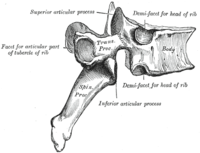
Photo from wikipedia
Abstract Rationale: Spinal tuberculosis (TB) is the most common in bone and joint TB, of which vertebral TB is more common, while accessory TB is rare. The incidence of isolated… Click to show full abstract
Abstract Rationale: Spinal tuberculosis (TB) is the most common in bone and joint TB, of which vertebral TB is more common, while accessory TB is rare. The incidence of isolated adnexal lesions in spinal TB is 2% to 3%. It is difficult to distinguish the imaging changes of spinal adnexal TB from other types of spinal infections and spinal tumors, and the pathological diagnosis of spinal TB is often atypical. Here, we report a case of isolated lumbar facet joint TB. Patient concerns: A 64-year-old female patient had an 8-month history of low back pain, decreased pinprick sensation in the left anterior middle thigh area, weakening of the patellar tendon reflex of the left lower limb, and enhanced MRI of the lumbar vertebrae showed bone destruction at the left superior and inferior articular process of the lumbar 2 to 3 and the encapsulated calcification containing the lesion around the articular process. The enhanced scan showed solid part and septal enhancement, and the lesion protruded to the left and posterior side of the spinal canal, and the left posterior edge of the dural sac was compressed at the same level. Conservative treatment for 8 months was ineffective. Diagnoses: L2–3 vertebral lamina, facet joint, and intraspinal space-occupying Lamina TB. Interventions: The diagnostic treatment scheme for anti-TB drugs was routinely administered before the operation. Isoniazid (300 mg), rifampicin (450 mg), ethambutol (750 mg), and pyrazinamide (1500 mg) were administered orally once daily after breakfast for 1 month, as anti-TB treatment for 1 month. Posterior lumbar total laminectomy and decompression, pedicle screw internal fixation, TB focus debridement, lumbar intertransverse process bone graft fusion was performed 1 month later. Outcomes: The patient was relieved of symptoms after surgical treatment and anti-tubercular medication. Lessons: We present a case of isolated TB of the lumbar facet joint, which was initially diagnosed as L2–3 vertebral lamina, facet joint, and intraspinal space-occupying osteochondroma. For patients with long-term low back pain, it is suggested to follow-up with lumbar computed tomography and lumbar magnetic resonance imaging when conventional X-ray examination does not show any lesion. Despite its rarity, isolated TB of the lumbar facet joint should be highly suspected in elderly patients with pulmonary TB, low-grade fever, and waist pain.
Journal Title: Medicine
Year Published: 2021
Link to full text (if available)
Share on Social Media: Sign Up to like & get
recommendations!